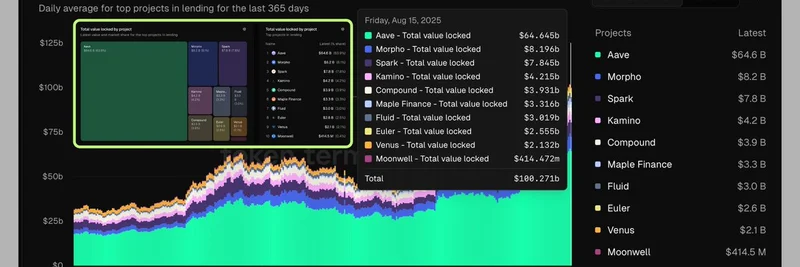In the ever-evolving world of decentralized finance (DeFi), lending protocols are making waves, and a recent thread from Satyam Singh (@Satyams2468) on X highlights just how massive this sector has become. Total deposits into these protocols have now eclipsed $100 billion, marking a staggering 3.13x increase from $32 billion just a year ago. Leading the charge is Aave, which commands a whopping $64.6 billion in total value locked (TVL), accounting for 64% of the entire lending market.
Why DeFi Lending is Booming
DeFi lending protocols allow users to borrow and lend cryptocurrencies without traditional banks, using smart contracts on blockchains like Ethereum. This setup eliminates intermediaries, reduces costs, and opens up opportunities worldwide. According to the thread, Aave has experienced 3-4x growth in key metrics like TVL, fees, revenue, and active loans over the past year. But this is just the beginning—Satyam believes we've barely scratched the surface, with adoption potentially reaching only 1% of its future potential. He predicts deposits will compound exponentially in the coming years.
Lending Protocols: The Future of Banking?
The thread dives into why DeFi lending could eclipse traditional banks and become the world's largest financial institutions. Here's a breakdown of the key points:
Borderless Access to Capital: Anyone with an internet connection can participate, regardless of location. No more geographical barriers to borrowing or lending.
Higher Yields for Lenders: Traditional savings accounts offer paltry 1-3% interest, but DeFi protocols deliver much better returns, making them attractive for savvy investors.
Instant, 24/7 Liquidity: Loans and repayments happen in minutes, anytime, anywhere—no paperwork or waiting periods.
Diverse Collateral Options: Beyond crypto, users can collateralize NFTs, tokenized stocks, gold, silver, and more, expanding the ecosystem.
Global Rate Arbitrage: Borrow at low rates in one place and lend at higher yields elsewhere. For example, use Apple stock as collateral on Aave at 5% interest.
Inclusive Participation: From hedge funds and corporations to governments and non-profits, everyone can join this open system.
These features position DeFi lending as a game-changer, especially in regions with high interest rates or stagnant markets.
Tokenization: Unlocking Global Investments
A standout example in the thread contrasts buying Apple stock traditionally versus through DeFi. In the old way, you'd need a broker, KYC (Know Your Customer) verification, tax forms, and currency conversions—often with fees up to 2% and restrictions for sanctioned countries. Tokenization changes everything: it turns real-world assets like stocks into digital tokens on the blockchain, allowing anyone to buy U.S. equities without KYC, at low fees, and from anywhere.
This could drive massive demand. Imagine borrowing against tokenized stocks on Aave at 4-6% interest, with uniform rates worldwide—whether you're in America or Burundi. As more assets come on-chain, DeFi lending stands to benefit hugely.
Aave's Massive Growth Potential
Satyam crunches the numbers: The top 10 U.S. stocks have a combined market cap of $23 trillion. If just 10% tokenizes in the next five years ($2.3 trillion) and 10% of that flows into Aave for lending ($230 billion), the protocol's TVL could skyrocket. Even without assuming stock growth (though he notes a likely 2x increase), he forecasts Aave hitting $500-700 billion in TVL by 2030.
This optimism isn't unfounded. As blockchain technology matures, more institutional players will enter, boosting liquidity and innovation in DeFi lending.
Community Reactions and Broader Implications
The thread sparked engaging replies, with users like @tokenterminal praising the write-up and others bookmarking it for its insights. Projects like Fluid and Euler were mentioned as strong contenders, showing the competitive yet collaborative nature of DeFi.
For blockchain enthusiasts and meme token traders alike, understanding DeFi lending is crucial. Meme tokens often thrive in volatile markets, and lending protocols provide ways to leverage positions, earn yields, or hedge risks. As meme ecosystems integrate with DeFi, tools like Aave could become essential for maximizing returns.
If you're new to this space, start by exploring Aave (aave.com) or checking out data platforms like Token Terminal for real-time metrics. The future of finance is decentralized, and lending protocols are at the forefront.
For the full thread, head over to Satyam Singh's post on X. What's your take on DeFi lending's potential? Share in the comments below!



